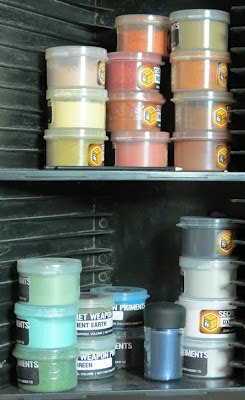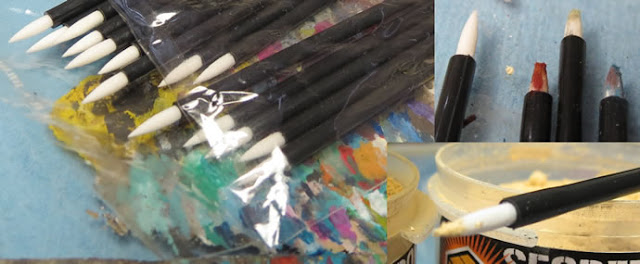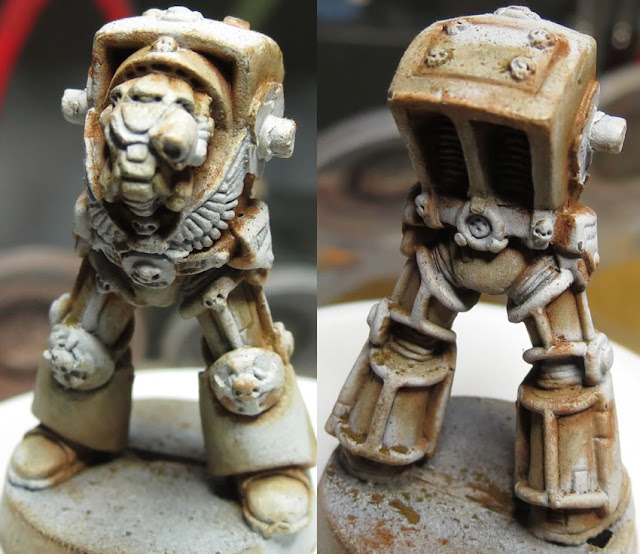 Pigments, also known as "weathering powders" by some, provide fantastic effects that we can add to our miniatures, more so than just weathering. Pigments can be used for shading, blending, creating a "weathered" or "worn" look, adding build up like dirt / grime / patina, even colouring an entire model or making your own paint. The reason I prefer to simply call them "pigments" (other than it being their true name) is because of all of those uses - well beyond just "weathering."
Pigments, also known as "weathering powders" by some, provide fantastic effects that we can add to our miniatures, more so than just weathering. Pigments can be used for shading, blending, creating a "weathered" or "worn" look, adding build up like dirt / grime / patina, even colouring an entire model or making your own paint. The reason I prefer to simply call them "pigments" (other than it being their true name) is because of all of those uses - well beyond just "weathering."I haven't seen too many places that sell them. I got mine from Secret Weapon Miniatures and the sets will give you the most bang for your buck. Personally, I find that the browns, reds, yellows, black and white are the ones I use most often vs the blues and greens.
You'll also notice a thin vial in that photo too. This is actually a pigment from MAC Cosmetics. These are crazy overpriced though, and TheWife picked up this one cheap (surplus) for us to try. (I'll cover how it turns out in a later post) Yup, that's right... pigments work a lot like make-up.
What exactly are "Pigments"?
Well, pigments are powder that get rubbed or brushed on your models.
- Like paint, certain pigments cover colours better than others.
- Like washes, they add to the colour that already exists instead of completely covering.
- Pigments will fill cracks and crevices more than washes, and in these cases will usually completely cover whatever colour is in the recess..
- Unlike paint, pigments have an innate ability to blend, making for very soft and smooth transitions OR to get rubbed over something you've already blended to clean it up.
- Pigments are best used as a final step and don't layer very well. It's all powder, so rubbing powder on powder pushes it around.
- Pigments don't work well on edges, corners or very smooth surfaces.
- You can't wash (well) on top of a pigment. Though washing crevices pigments have gotten in to will darken things up.
More than just a powder, pigments are what you would have if your paints didn't have any liquid. You can actually make paints or washes out of them by mixing with things like Matte Medium or water.
Did you ever paint with water colours? Solid bricks of paint that you'd run wet brushes over to pick up the colour? Same thing, but crushed in to powder. (Haven't actually tried making my own pigments yet)
I've read of people using pencil lead dust as a metallic pigment.
To apply pigments, you can use a paint brush - stiff for detail work, soft to spread it over a larger area. How much pigment to get on your applicator will depend on how you're using them. For blending colours on surfaces, you just want a light dusting - enough to colour without getting a visible amount of pigment. To cover a larger area, or applying it as rust / dirt / etc, get a bunch of pigment and freely apply it - this'll get the pigment all over the place, so just be sure to use enough pressure to press it into the model so it doesn't fall off.
I prefer to use disposable felt-tip eye-liner brushes for detail work. They're stiff enough to apply and have a nice tip, but soft enough not to scratch. the paint. (Think of a felt-tip marker without the ink) Unfortunately, I haven't been able to find them for purchase anywhere but from Hong Kong on eBay. First found one at a MAC make-up counter for testing, but they wouldn't sell them to me.
What effects do Pigments create?
Below, you can see how I've taken armour painted white, covered it in black pigment and actually just used my finger to rub and clean off the edges. This created nice black armour while bringing the white edges back as a highlight.
I also used a green pigment on Madrak's skin to help blend the layers of colours. In the past, I'd use a wash for this, which work pretty good... but pigments seem to apply a more natural "dry" effect.
Shading Pigments
Pigments already shade your model and do it very smoothly, so there's not a whole lot you may want to shade. Painting on them will probably be unclean and blocky compared to the nice blend you already have. BUT, you may want to intensify the deepest shadows.
Because of how thick pigments are in concentrate, they'll usually take over the cracks and can dull them. Now, it depends on the look you're going for, but you can leave them as is or try one of the following methods to make the shadows stronger.
- Water
- By painting a little water on, it turns pigment in to paint, thereby darkening the pigment. Not by a lot, but some, and guaranteed to be a shade of the colour you're working with.
- Paint / Wash: Darker Shade
- You can also use a paint that's just a darker shade of your pigments... so, normal shading. In the example below, I've used a darker brown.
- Paint / Wash: Black
- It stands out more, but I've mentioned it before - if you want a really high-contrast look, you can shade using black. (though it can look unnatural and too dark)

Varnishing pigments?
A common misconception is that pigments, being a powder, have to be varnished, or that they'll fall off the model. It depends how you apply them. When people wear make-up, does the powder just come off? No, it tints the skin. Can it come off? Yes, under a few situations like rubbing too hard, wetness or if too much powder was used / applied too lightly.
Minis that are going to be used to wargame should probably be varnished since all the hand-contact and shuffling in boxes will eventually wear the pigment off. (Or temporarily stain your fingers if they're sweaty or moist from a cold beverage.) If the model is just for display purposes, then you should be able to safely leave the model unvarnished.
I discuss it fully in my post about Varnishing Your Models, but I'll repost the image here. Basically, varnish changes what the pigments look like. Being powder, it comes in contact with varnish and some will dissolve into more of a wash consistency.
Dark Angels Deathwing Terminator coloured using Pigments
 |
| Test model, today |
 |
| Deathwing, circa 1997 |
This was just a rough test for the purposes of this tutorial, but it should give you an idea of just how far pigments can go.
In this example, I'm working Dark to Light on a White Base.
As a first step, I rub in all the shadows. Nothing complicated here. You can see that I use an uneven style and how certain areas I've gone very liberal with the pigment.
Worth noting - For a fully painted model, this could be a final step. All that brown "dirt" works its way in to the crevices. Alternately, this could be a red "rust" or green "moss".
As a second step, I've used a lighter brown. As I apply it, I rub it in to the edges of the darker brown. Not too far - as I don't want to overpower the darker shadows. Just enough though to blend. As mentioned above, pigments WANT to blend. They just naturally do it. Look between the above and below photos at the blend.
Here I'm getting in to a lighter colour - almost a khaki. I used this for most of the armour except where I planned on highlighting. Again, lookit it blend. It WANTs to blend!
To highlight, I've used a lighter tan colour. May have
Then I go back and re-apply the darkest brown, bringing out shadows where I want them.
To bring out more detail, I've used a green pigment on the wings and black on the joints and exhaust.
Don't criticize me here, but I've just whipped up some quick gold and red additions. Nothing fancy or detailed, just for the sake of the tutorial.
After painting all those little details I decided the model was still missing something. It's got the look of a mini that hasn't been shaded or washed. I've used a Devlan Mud wash, painted only in to the shadows, just to intensify things a little bit.
Here are the final photos after I shaded the model, included one with a side-by-side to the (albeit poorer quality) older model.














